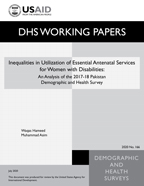- PUBLICATIONS
- JOURNAL ARTICLES
- ACCESS PUBLICATIONS
Publications Summary
- Document Type
- Working Papers
- Publication Topic(s)
- Disability
- Country(s)
- Pakistan
- Survey
- Pakistan DHS, 2017-18
- Language
- English
- Recommended Citation
- Hameed, Waqas, and Muhammad Asim. 2020. Inequalities in Utilization of Essential Antenatal Services for Women with Disabilities in Pakistan. DHS Working Paper No. 166. Rockville, Maryland, USA: ICF
- Download Citation
- RIS format / Text format / Endnote format
- Publication Date
- July 2020
- Publication ID
- WP166
Download
 Inequalities in Utilization of Essential Antenatal Services for Women with Disabilities (PDF, 660K)
Inequalities in Utilization of Essential Antenatal Services for Women with Disabilities (PDF, 660K)
Download this publication
There is no printed copy available to order.
